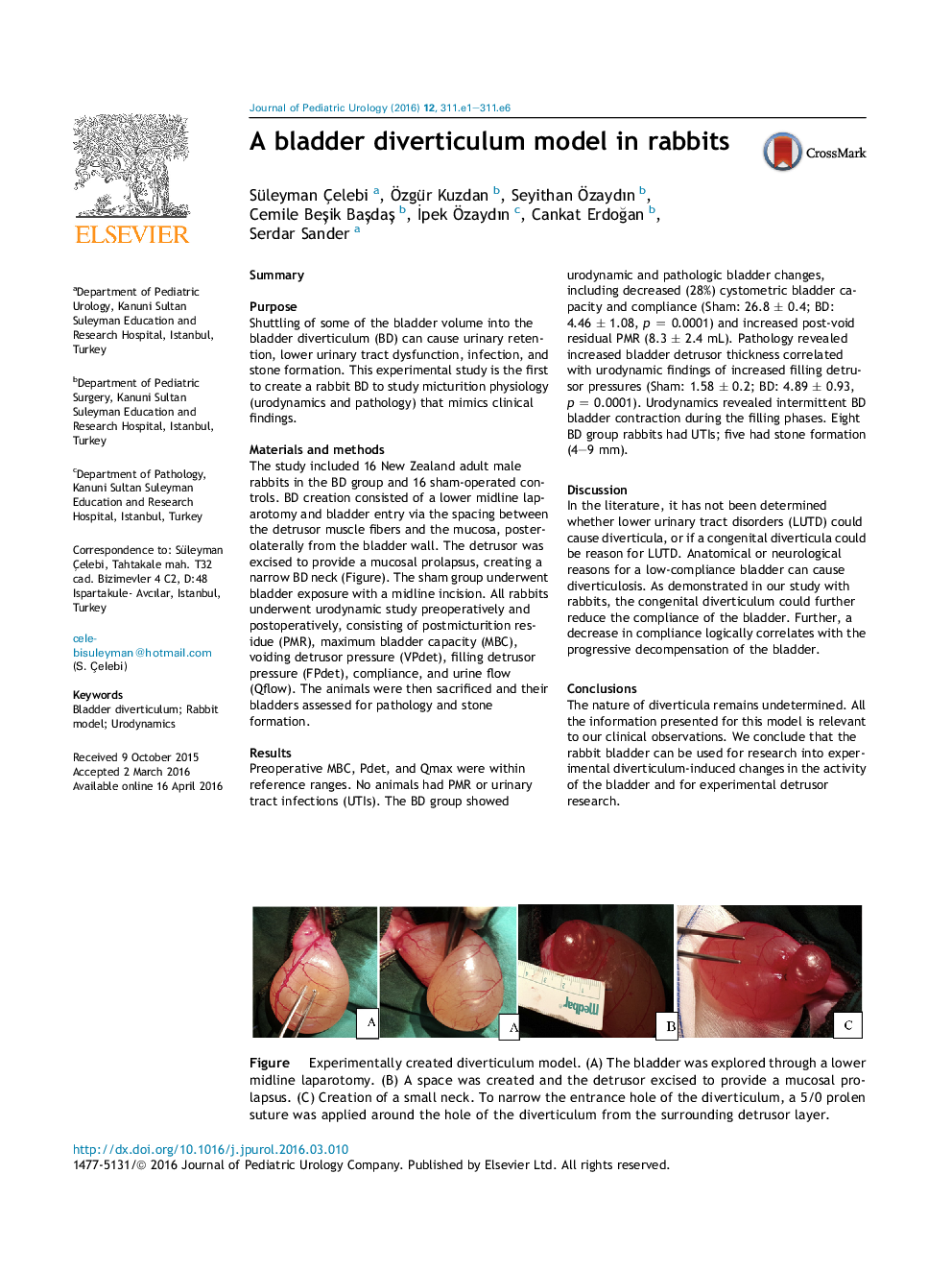| Article ID | Journal | Published Year | Pages | File Type |
|---|---|---|---|---|
| 5718784 | Journal of Pediatric Urology | 2016 | 6 Pages |
SummaryPurposeShuttling of some of the bladder volume into the bladder diverticulum (BD) can cause urinary retention, lower urinary tract dysfunction, infection, and stone formation. This experimental study is the first to create a rabbit BD to study micturition physiology (urodynamics and pathology) that mimics clinical findings.Materials and methodsThe study included 16 New Zealand adult male rabbits in the BD group and 16 sham-operated controls. BD creation consisted of a lower midline laparotomy and bladder entry via the spacing between the detrusor muscle fibers and the mucosa, posterolaterally from the bladder wall. The detrusor was excised to provide a mucosal prolapsus, creating a narrow BD neck (Figure). The sham group underwent bladder exposure with a midline incision. All rabbits underwent urodynamic study preoperatively and postoperatively, consisting of postmicturition residue (PMR), maximum bladder capacity (MBC), voiding detrusor pressure (VPdet), filling detrusor pressure (FPdet), compliance, and urine flow (Qflow). The animals were then sacrificed and their bladders assessed for pathology and stone formation.ResultsPreoperative MBC, Pdet, and Qmax were within reference ranges. No animals had PMR or urinary tract infections (UTIs). The BD group showed urodynamic and pathologic bladder changes, including decreased (28%) cystometric bladder capacity and compliance (Sham: 26.8 ± 0.4; BD: 4.46 ± 1.08, p = 0.0001) and increased post-void residual PMR (8.3 ± 2.4 mL). Pathology revealed increased bladder detrusor thickness correlated with urodynamic findings of increased filling detrusor pressures (Sham: 1.58 ± 0.2; BD: 4.89 ± 0.93, p = 0.0001). Urodynamics revealed intermittent BD bladder contraction during the filling phases. Eight BD group rabbits had UTIs; five had stone formation (4-9 mm).DiscussionIn the literature, it has not been determined whether lower urinary tract disorders (LUTD) could cause diverticula, or if a congenital diverticula could be reason for LUTD. Anatomical or neurological reasons for a low-compliance bladder can cause diverticulosis. As demonstrated in our study with rabbits, the congenital diverticulum could further reduce the compliance of the bladder. Further, a decrease in compliance logically correlates with the progressive decompensation of the bladder.ConclusionsThe nature of diverticula remains undetermined. All the information presented for this model is relevant to our clinical observations. We conclude that the rabbit bladder can be used for research into experimental diverticulum-induced changes in the activity of the bladder and for experimental detrusor research.Download high-res image (344KB)Download full-size imageFigure. Experimentally created diverticulum model. (A) The bladder was explored through a lower midline laparotomy. (B) A space was created and the detrusor excised to provide a mucosal prolapsus. (C) Creation of a small neck. To narrow the entrance hole of the diverticulum, a 5/0 prolen suture was applied around the hole of the diverticulum from the surrounding detrusor layer.
